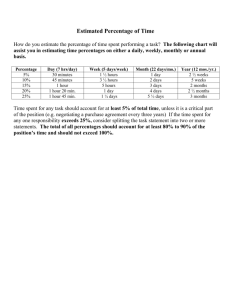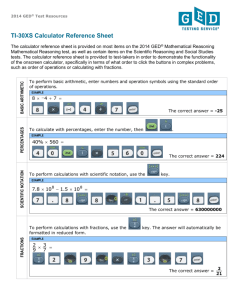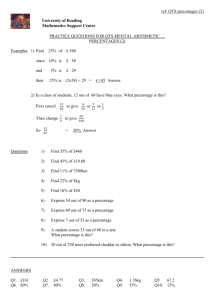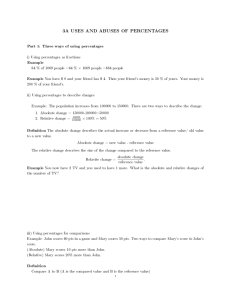Reviewing percentages
advertisement
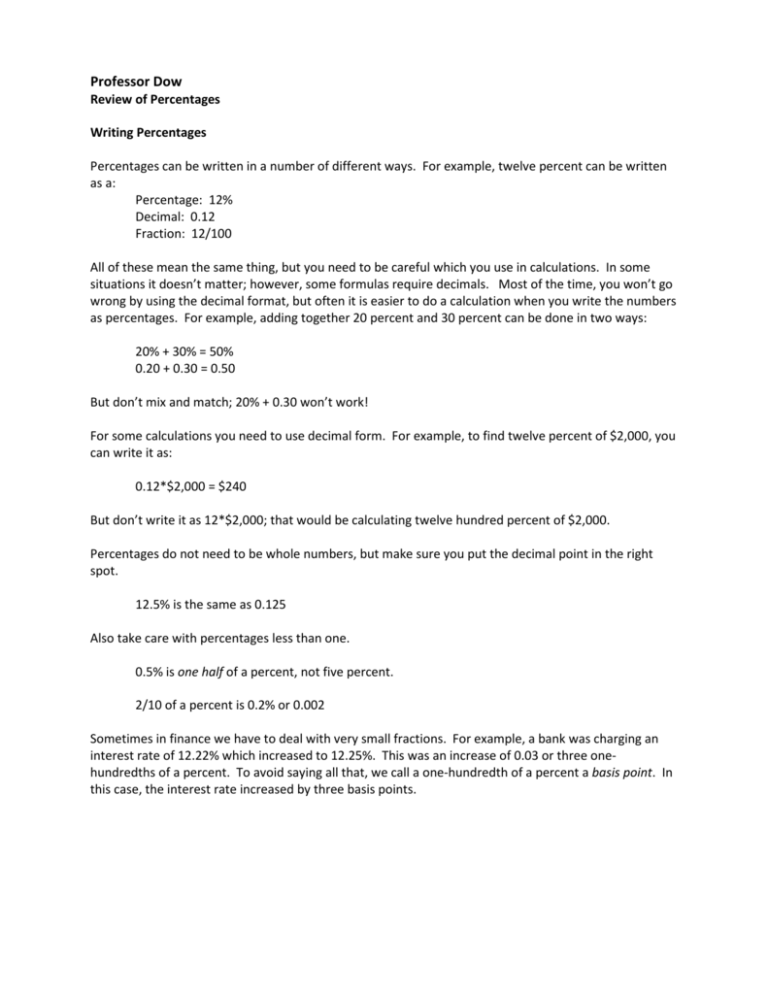
Professor Dow Review of Percentages Writing Percentages Percentages can be written in a number of different ways. For example, twelve percent can be written as a: Percentage: 12% Decimal: 0.12 Fraction: 12/100 All of these mean the same thing, but you need to be careful which you use in calculations. In some situations it doesn’t matter; however, some formulas require decimals. Most of the time, you won’t go wrong by using the decimal format, but often it is easier to do a calculation when you write the numbers as percentages. For example, adding together 20 percent and 30 percent can be done in two ways: 20% + 30% = 50% 0.20 + 0.30 = 0.50 But don’t mix and match; 20% + 0.30 won’t work! For some calculations you need to use decimal form. For example, to find twelve percent of $2,000, you can write it as: 0.12*$2,000 = $240 But don’t write it as 12*$2,000; that would be calculating twelve hundred percent of $2,000. Percentages do not need to be whole numbers, but make sure you put the decimal point in the right spot. 12.5% is the same as 0.125 Also take care with percentages less than one. 0.5% is one half of a percent, not five percent. 2/10 of a percent is 0.2% or 0.002 Sometimes in finance we have to deal with very small fractions. For example, a bank was charging an interest rate of 12.22% which increased to 12.25%. This was an increase of 0.03 or three onehundredths of a percent. To avoid saying all that, we call a one-hundredth of a percent a basis point. In this case, the interest rate increased by three basis points. Percentage Increases and Decreases Often in finance we are concerned by how much something has changed, for example, how much the price of a stock has increased over the last year. The percentage change is calculated as the change divided by the initial value. The price of ABC stock goes from $40 to $42. The percentage change is calculated as the difference, $2, divided by the initial value, $40. 2/40 = 0.05 or 5%. It works the same way with decreases. If the price ABC stock fell from $80 to $64, the change is -$16. The percentage change is -16/80 = -0.20 or -20%. Remember, always divide by the initial value. Given a percentage change, we can calculate the new value. For example, how much is the price of ABC stock if it was $26 and it increased by 20%? The new price of the stock will equal $26 plus the increase. We multiply $26 by (1.20) where the 1 represents the initial value and the 0.20 is the percentage increase. The “1 + percentage change” is commonly called the “multiplier”. $26(1.20) = $31.20 It works the same way for a price decrease. If the initial price is $26 and it declines by 20%, then to find the new price we multiply $26 by the multiplier, which equals 1 plus -0.20, or 0.8. $26(0.8) = $20.80. In finance, when talking about returns, the multiplier is also called the “return relative”. So a 20% return would be 0.20 or a return relative of 1.20. Multipliers can be combined if we have multiple changes. For example, the price of ABC stock started at $30, increased by 10%, decreased by 8%, and then increased by 12%. Its new value will equal, $30(1+0.10)(1-0.08)(1+0.12) = $34 Percentage Points vs. Percentage Changes If an interest rate went from 20% to 30% this is an increase of 10 percentage points (30-20) or a 50 percent increase (10/20). Sometimes people will call this a 10 percent increase, but it’s better to use the term ‘percentage points’ so that there is no confusion. Weighted Averages The standard way of finding an average is add together all of the items and then divide by the number of items. However, sometimes the items being averaged do not have equal importance. Say that you received an “A” in a 3-unit class and a “C” in a 1-unit class. Taking a simple average would give you a “B”, but that does not take into account that the first class has more units. Instead, we should give more weight to the first class which makes up 75% of your total units. If we weight each class by its share of units, your GPA is, 0.75*4 + 0.25*2 = 3.5 Weighted averages show up in a number of different calculations in finance. Problems: 1. What is 8% of 4,200? 2. 12% of $16,000 goes to Bill and 16% goes to Maria. How much do Bill and Maria collectively get? don’t calculate the amounts separately, just do one calculation for the total. 3. The current rate on a loan from a bank is 6.35%. If the interest rate increased by 7 basis points, how much would it be? 4. Write 1/4th of a percent as a decimal. 5. Your investment of $11,800 increased by 17%. How much do you have? 6. Your investment of $2,500 decreased by 6%. How much do you have? 7. Your investment of $210,000 first increased by 8% then decreased by 2%. How much do you have? 8. In your first semester at CSUN, you received an “A” in a 3-unit class, a “B” in another 3-unit class and a “C” in a 4-unit class. What is your GPA? Answers: 1. 336 2. $4,480 3. 6.42% 4. 0.0025 5. $13,806 6. $2,350 7. $222,264 8. 2.9
